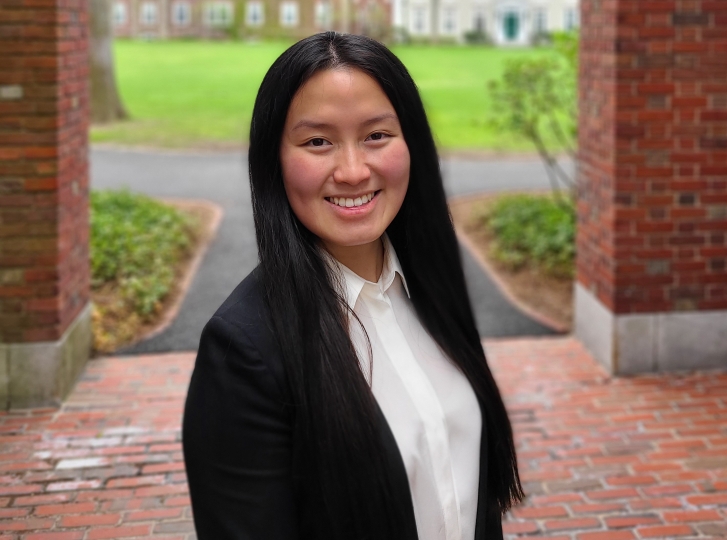Sarah Goldfarb, S.B. '22, designed a hydrogel to improve bone fracture healing for her senior capstone project. (Credit: Sarah Goldfarb)
Engineering Design Projects (ES 100), the capstone course at the Harvard John A. Paulson School of Engineering and Applied Sciences, challenges seniors to engineer a creative solution to a real-world problem.
Engineering a Hydrogel for Controlled Delivery of SIK2/SIK3 siRNAs in a Bone Fracture Model
Sarah Goldfarb, S.B. ‘22, engineering sciences (bioengineering)
What did you do for your project?
The United States reports over 6.8 million bone fractures annually, which cost over $17 billion in direct medical costs. While current treatment options – such as cast immobilization and functional braces – can aid in the healing process, most patients must wait several weeks to months to heal. Moreover, while most fractures eventually heal over time, approximately 10% result in delayed or impaired healing. The objective of this senior design project was to engineer a novel drug delivery system to accelerate and improve bone fracture healing. This was done through developing compounds called polyplexes, which combined small interfering RNA (siRNA) and certain organic nanoparticles. These were then embedded in a hydrogel that could be applied at the site of the fracture.
How did you come up with this idea for your final project?
I was inspired to apply the engineering techniques and approaches I learned in class to the biological research I was doing at the Wein Lab. So I engineered a novel hydrogel delivery system that may be used to increase bone mass and formation, and provide the initial steps for therapeutic applications.
Are there other real-world challenges that this project addresses?
Beyond bone fracture applications, which are far-reaching on their own, this drug delivery system has the potential to be translated to a vast array of other clinical contexts. This drug delivery system is highly modular and can be modified to incorporate different siRNA sequences based on clinical need. Many diseases are caused by dysregulation of gene expression. Some diseases may be treated by inhibition of specific gene expression. This project provides the first step towards a novel solution for targeted, localized, and sustained gene knockdown for bone fractures and beyond.
How did your project come together over the course of the year?
Since joining the Wein Lab the summer after my first year of college, I knew that the amazing mentorship and support that they provided would be critical for my success during my thesis. However, since all of my lab work at the Wein Lab had been strictly molecular biology research, I needed to find a way to integrate engineering and design into my project. Thus, Professor Wein connected me with Professor Natalie Artzi who now serves as my co-advisor for my thesis.
Over the spring and summer before my senior year, I spent a lot of time reading relevant scientific literature. I worked alongside members of both the Wein and Artzi Labs in order to learn new techniques, such as how to analyze flow cytometry data and synthesize hydrogels.
Once senior year arrived, the plan for my thesis was solidified, and it involved three principal stages: optimizing the nanoparticle/siRNA polyplex, which went lasted from September until November; optimizing the hydrogel, which took up most of the remainder of the year; and measuring and verifying the generated prototypes, which is still ongoing.
What part of the project proved the most challenging?
Learning how to identify the problems with the original designs and improving upon them after each iteration was quite challenging, but it also taught me how to think more critically about the tests I was performing and dig deep into the rationale behind each step.
What part of the project did you enjoy the most?
The most rewarding and intellectually challenging component of my project was learning how to apply my molecular biology background and skills to an engineering project. Prior to this, I had no experience in an engineering lab and very few of the relevant technical engineering skills. Through learning these techniques, having the opportunity to lead the project, and acting as the liaison between the two labs, I was able to learn so much and truly appreciate the translational potential of the biology research I had been doing for years.
What new skills did you gain through this project?
Through this project, I learned a lot of tangible technical skills, such as synthesizing hydrogels and polyplexes. More importantly, however, I believe that I learned a lot about planning and organizing my own project and working in an interdisciplinary team. By working at two labs—one with a greater emphasis on biology and one with a greater focus on engineering—I was able to learn from mentors with diverse backgrounds and incorporate their teachings into my design decisions and experiments.
Press Contact
Matt Goisman | mgoisman@g.harvard.edu
